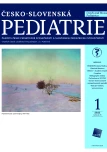Noninvasive monitoring of vital signs of the newborn
Authors:
Burčková Hana 1,2; Wiedermannová Hana 1,2; Čubík Jakub 3; Kepák Stanislav 3; Pavlíček Jan 2,4,5
Authors‘ workplace:
Oddělení neonatologie, FN Ostrava
1; Lékařská fakulta, Ostravská univerzita, Ostrava
2; Fakulta elektrotechniky, a informatiky, VŠB – Technická univerzita, Ostrava
3; Klinika dětského lékařství, FN Ostrava
4; Centrum biomedicínského, výzkumu, FN Hradec Králové
5
Published in:
Čes-slov Pediat 2023; 78 (1): 34-39.
Category:
Comprehensive Report
doi:
https://doi.org/10.55095/CSPediatrie2023/006
Overview
Monitoring of vital signs is an essential and important part of the care for newborns in all types of neonatology departments. The basic monitored parameters include heart rate, respiratory rate, and peripheral blood oxygen saturation. Monitoring methods can be classified to invasive and non-invasive, the latter further into contactless and (more widespread in practice) contact methods. The review article presents standard as well as less common standard methods of non-invasive measurement of neonatal vital signs. At the end of the article, the authors present an experimental system including a sensory pad with a built-in optical fiber for sensing the heart and respiratory rate of a newborn developed in cooperation with scientists of the Technical University of Ostrava.
Keywords:
Neonatology – noninvasive monitoring – vital signs
Sources
1. Blanik N, Heimann K, Pereira C, et al. Remote vital parameter monitoring in neonatology – robust, unobtrusive heart rate detection in a realistic clinical scenario. Biomed Eng-Biomed Te 2016; 61(6): 631–643.
2. Pereira CB, Yu X, Goos T, et al. Noncontact monitoring of respiratory rate in newborn infants using thermal imaging. IEEE T Bio-Med Eng 2019; 66(4): 1105–1114.
3. Cobos-Torres JC, Abderrahim M, Martínez-Orgado J. Non-contact, simple neonatal monitoring by photoplethysmography. Sensors 2018; 18(12): 4362.
4. Anton O, Fernandez R, Rendon-Morales E, et al. Heart rate monitoring in newborn babies: a systematic review. Neonatology 2019; 116(3): 199–210.
5. Kevat AC, Bullen DVR, Davis PG, et al. A systematic review of novel technology for monitoring infant and newborn heart rate. Acta Paediatr 2017; 106(5): 710–720.
6. Marchionni P, Scalise L, Ercoli I, et al. An optical measurement method for the simultaneous assessment of respiration and heart rates in preterm infants. Rev Sci Instrum 2013; 84(12): 121705.
7. Di Fiore JM. Neonatal cardiorespiratory monitoring techniques. Semin Neonatol 2004; 9(3): 195–203.
8. McVea S, McGowan M, Rao B. How to use saturation monitoring in newborns. Arch Dis Child Educ Pract 2019; 104(1): 35–42.
9. Joshi R, Bierling B, Feijs L, et al. Monitoring the respiratory rate of preterm infants using an ultrathin film sensor embedded in the bedding: a comparative feasibility study. Physiol Meas 2019; 40(4): 045003.
10. Urbanová Z, Šamánek M. Dětská kardiologie do kapsy. Praha: Mladá fronta 2013 : 10–20.
11. Janota J, Straňák Z. Neonatologie. In: Burianová I, Kubuš P. Arytmie. Praha: Mladá fronta 2013 : 42–52.
12. Sato S, Ishida-Nakajima W, Ishida A, et al. Assessment of a new piezoelectric transducer sensor for noninvasive cardiorespiratory monitoring of newborn infants in the NICU. Neonatology 2010; 98(2): 179–190.
13. Henry C, Shipley L, Ward C, et al. Accurate neonatal heart rate monitoring using a new wireless, cap mounted device. Acta Paediatr 2021; 110(1): 72–78.
14. Kraaijenga JV, Hutten GJ, de Jongh FH, et al. Transcutaneous electromyography of the diaphragm: A cardio-respiratory monitor for preterm infants. Pediatr Pulm 2015; 50(9): 889–895.
15. van Leuteren RW, Kho E, de Waal CG, et al. Cardiorespiratory monitoring in the delivery room using transcutaneous electromyography. Arch Dis Child - Fetal 2021; 106(4): 352–356.
16. Gangaram-Panday NH, van Essen T, Goos TG, et al. Dynamic light scattering: a new noninvasive technology for neonatal heart rate monitoring. Neonatology 2020; 117(3): 279–286.
17. Černý M. Přechodná tachypnoe novorozence. In: Straňák Z, Janota J. Neonatologie. 2., přepracované a rozšířené vydání. Praha: Mladá fronta 2015 : 411–414.
18. Šemberová J, Straňák Z. Apnoe a bradykardie. In: Straňák Z, Janota J. Neonatologie. 2., přepracované a rozšířené vydání. Praha: Mladá fronta 2015 : 74–80.
19. Maurya L, Kaur P, Chawla D, et al. Non-contact breathing rate monitoring in newborns: A review. Comput Biol Med 2021; 132 : 104321
20. Abbas AK, Heimann K, Jergus K, et al. Neonatal non-contact respiratory monitoring based on real-time infrared thermography. BioMed Eng OnLine 2011; 10(1): 93.
21. Monitory dechu babysense. Dostupné na: https://www.babysense.cz/
22. Huizing MJ, Villamor-Martínez E, Vento M, et al. Pulse oximeter saturation target limits for preterm infants: a survey among European neonatal intensive care units. Eur J Pediatr 2017; 176(1): 51–56.
23. Nitzan M, Nitzan I, Arieli Y. The various oximetric techniques used for the evaluation of blood oxygenation. Sensors 2020; 20(17): 4844.
24. Ochiai M, Kurata H, Inoue H, et al. Transcutaneous blood gas monitoring among neonatal intensive care units in Japan. Pediatr Int. 2020; 62(2): 169–174.
25. Villarroel M, Guazzi A, Jorge J, et al. Continuous non-contact vital sign monitoring in neonatal intensive care unit. Health Technol Lett 2014; 1(3): 87–91.
Labels
Neonatology Paediatrics General practitioner for children and adolescentsArticle was published in
Czech-Slovak Pediatrics

2023 Issue 1
Most read in this issue
- Interpretation of acid-base disorders
- Cyanotic heart disease
- A very unusual cause of abdominal pain
- Severe iron intoxication in a 16-year-old patient
